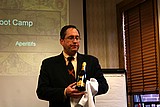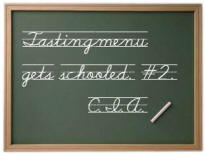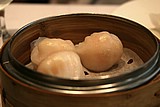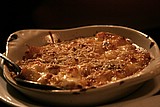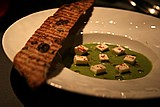Home |
Restaurants by City
|
Food Photography |
Archive | Philosophy |
![]()
Right now we are eating in Seattle, Washington.
|
Tuesday
2006
Permalink
|
A Week at the Culinary
Institute of America (continued) - Lectures, Hyde Park, NY,
tasted on December 19-22, 2005 It's time to focus on the
actual class we took at the C.I.A. A little background is in order.
As I mentioned before, we owe a debt to Michael Ruhlman who wrote
The Making of a Chef The class basically spans four days. The days are filled with lecture, cooking, eating the food we cooked, and dining at the on-campus restaurants in the evening. There are several different boot camps offered. (Not as much variety as offered at the pro level but still decent.) The nice thing about the boot camp is that for people who've never been to a professional cooking school it's really a nice introduction. They provide you with the chef outfits. You can purchase your knife and tool kit from them. And they make the class into really more of an experience with tours of the campus and even a guest lecture or two. For most people the boot camp seems like a really great option. For us, even though we had a great time, it turns out it actually may not have been the optimal choice, but more on that later. We'd traveled all the way out to Hyde Park, NY in the dead of winter to cook. So I think it's fair to say that sitting in a cramped alternately cold and hot classroom wasn't our top priority. At the same time, as with any craft, there's a degree of theory you need to absorb before you put it into practice. And truthfully it was a relatively small percentage of the time we spent there. Mainly the main problem with our particular lectures were that our chef, a veteran of the C.I.A. and a nice guy weren't that great. Chef DeShetler (or Chef D as he had us call him) was without a doubt a guy you could learn a lot from. Lectures weren't his strong suit though. That said, for folks with a little less experience and knowledge the information conveyed was probably useful. For me personally, there wasn't a huge amount of new content and Chef D wasn't nearly as enthusiastic a lecturer as he was a presence in the kitchen. Luckily there was other stuff to do.
The C.I.A. produces pretty comprehensive text books that accompany
their classes. Our class was Small Plates Big Flavors, and the
accompanying book was Garde Manger, The Art and Craft of the Cold Kitchen There was one lecture by Chef D that was more interesting than the others... the one on food pairings or what goes well with other things. We sat down in a different classroom than our regular one and were confronted with a couple of dozen little plastic containers with tiny samples of various ingredients. Synergisms they called it. What goes with cauliflower? Brown butter and bread crumbs anyone? This was fun. I found that most of my answers as to what went with particularly ingredients was based on combinations I'd seen at some of my favorite restaurants. There was one lecture that really blew me away. This was our apertifs lecture by John Fischer. He was a long-time professional sommelier at some of the best restaurants in Manhattan including Windows on the World at the top of the World Trade Center before its destruction. Awhile back he took on a teaching role at the C.I.A. and we were glad he did. The guy was a fantastic speaker. I try to be open-minded when it comes to food. After all, how do you experience new things without being open-minded. And when it comes to alcohol I admit I've been lax. A few years ago I started getting much more into wine and felt like even though I'm no expert by any stretch of the imagination, I have a variety of wine that I enjoy and I feel like I'm more able to appreciate new wines when I try them. With other alcohol I've basically neglected my responsibilities. Mostly this is because especially when it comes to the harder liquors I really don't like the way they taste. I'm just a wuss essentially. So I had no idea what to expect from John Fischer's class on apertifs. Little did I know his fantastic speaking, informative content, and sampling of different apertifs would get me all excited about the topic. I'll likely never be Drink Boy, but I really enjoyed the class and went out and bought my first bottle of an apertif for home. We started off learning the proper way to open a bottle of sparkling wine so as not to hurt anyone. Then we traversed a variety of beverages including a sparkling wine from Italy. But two apertifs in particular left the biggest impression. The first was Lillet, a wine and fruit based beverage that Fischer made clear was a staple of his family around the holidays. This light drink was actually super refreshing and enjoyable (and all of us who attended the class had bought bottles for home within a few days of finishing the class). The other was Cynar, an artichoke based liqueur. In the interest of trying things, I was glad I tried it. Mostly so that I could avoid it at all costs in the future. It was a foul beverage. Artichoke based liqueur, definitely an acquired taste. Points for Alex who knew what it was and drank all of his.
Alex also pointed out we should plug Fischer's book At Your Service : A Hands-On Guide to the Professional Dining Room
|
|||
Our Sponsors
Free Car Listings Hot Tubs Stools Saunas Bar Stools - Calendar and Event Schedules - Food Events and Calendars - Wine Events and Calendars - Digital Photography Resources - Software for Advertisers - Jewish Gifts and Judaica - Howard Stern Podcast - ponytailed blogger Jonathan Schwartz

Browse tastingmenu
Home |
Restaurants by City X |
Food Photography |
Archive | Philosophy |
![]()
Free eBooks: All About Apples
| Autumn Omakase
More:
Discussion |
Cool Food T-Shirts |
Ingredients
| Markets |
Recipes
Search |
Blog FAQ |
Other
Blogs
Best of tastingmenu
|
City View
Entry: July 6, 2006 |
Blue Plate
Entry: June 19, 2006 |
L'Atelier de Joël Robuchon
Entry: July 18, 2006 |
Browse by City
Boston | Chicago | Houston | Las Vegas | Los Angeles | Maui | New York | Philadelphia | Portland | San Francisco | Seattle | Toronto | Utah | Vancouver | Washington D.C.
Bangkok | Beijing | Hong Kong | Seoul | Tokyo
Amsterdam | Berlin | Italy | London | Madrid | Paris | Vienna
Browse by Month
2006
2005
2004
2003
2002
2001
Comments, questions, or feedback:
info / at / tastingmenu / dot / com
All pages Copyright (c) 2001-2006 tastingmenu.com
Last modified 01/30/07.
